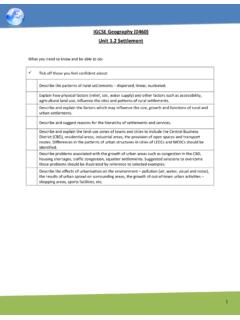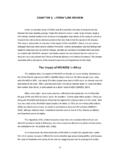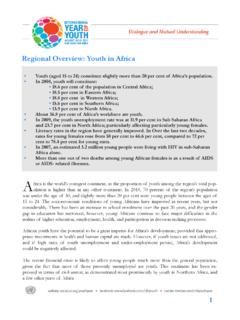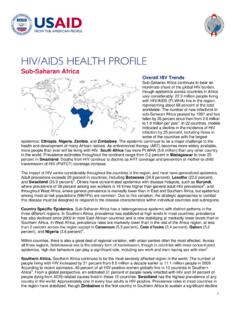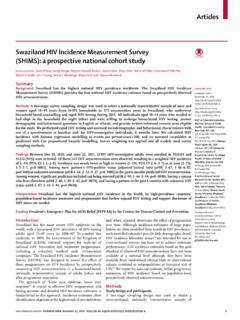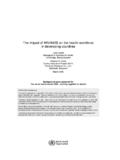Transcription of IGCSE Geography (0460) Unit 1.1 Population Dynamics
1 1 IGCSE Geography (0460) Unit Population Dynamics What you need to know and be able to do: Tick off those you feel confident about: Describe and suggest reasons for the rapid increase in the world s Population in recent times, the Population explosion . Define the main components influencing Population growth birth rate, death rate and migration. Describe the relationship between Population growth and resources and explain why problems may result in some areas such as over- Population and under- Population . Identify and suggest reasons for contrasting patterns of Population growth in different world areas as influenced by differences in birth rate, death rate and migration. Factors affecting these influences should be considered such as differences in social, economic and other factors, government policies and their impact upon birth rates, differences in health care, social and other factors influencing death rates, especially the impact of HIV/AIDS.
2 These factors should be illustrated by reference to selected examples. Describe the consequences (benefits and problems) of different patterns of Population growth. Consideration should be given to variations in the size and nature of dependent populations and standards of living. Identify and suggest reasons for different types of Population structure as shown by age/sex pyramids. Candidates should be able to describe Population pyramids and relate them to the different stages of the Demographic Transition Model. Identify the major influences on Population density and Population distribution. Reference should be made to physical, economic and human factors. Describe and suggest reasons for Population migrations. Reference should be made to internal movements such as rural-urban migration as well as to international migrations both voluntary and involuntary.
3 Be able to use, describe and interpret statistics, graphs, diagrams and maps. 2 Global Population growth At present, the world's Population is growing fast - though this has not always been the case. Until the 1800s the world's Population grew steadily but slowly for thousands of years. In 1820 the world's Population reached one billion. 150 years later, in the early 1970s, the world's Population reached three billion. In 1999, less than 30 years later, the Population doubled to six billion. The global rate of Population growth is now very fast (rising by about one billion every 15 years). Causes and rates of change The Population of any place changes over time. There are three main causes of Population change: Births - usually measured using the birth rate (number of live births per 1000 of the Population ).
4 Deaths - usually measured using the death rate (number of deaths per 1000 of the Population ) . Migration - the movement of people in and out of an area. Rate of change 3 Births and deaths are natural causes of Population change. The difference between the birth rate and the death rate of a country or place is called the natural increase, and you calculate the natural increase by subtracting the death rate per 1000 Population from the birth rate per 1000 Population : natural increase = birth rate - death rate The rate of natural increase or growth rate of a Population is given as a percentage, calculated by dividing the natural increase by 10. For example if the birth rate is 14 per 1000 Population , and the death rate is 8 per 1000 Population , then growth rate = 14 - 8 = 6 That is 6 / 1000, which is equal to Overpopulation is when there is not enough resources for the inhabitants in an area.
5 Inevitably this leads to famine, water and electricity shortages, increased unemployment. Under Population is when there is more resources than inhabitants in an area. Surplus in food and water results in wastes. Societal systems such as schools and hospitals will then not have enough demand to run at a sustainable level. So the cost per capita for the service will increase. Additionally, there will be less "working Population " this has a negative impact on a countries economy and will lead to an increase in taxation. Optimum Population is when there is enough resources for the number of inhabitants ( Population demand for goods is equal to the supply) Population distribution means the pattern of where people live. World Population distribution is uneven. Places which are sparsely populated contain few people.
6 Places which are densely populated contain many people. Sparsely populated places tend to be difficult places to live. These are usually places with hostile environments Antarctica. Places which are densely populated are habitable environments Europe. 4 Patterns of Population growth Rates of Population growth vary across the world. Although the world's total Population is rising rapidly, not all countries are experiencing this growth. In the UK, for example, Population growth is slowing, while in Germany and Italy the Population has started to decline. MEDCs have low Population -growth rates, with both low death rates and low birth rates. Population will decline if death rate is greater than birth rate. LEDCs on the other hand have high Population -growth rates. Both birth rates and death rates in LEDC populations tend to be high.
7 As LEDCs develop, however, improving healthcare leads to death rates falling - while birthrates remain high. It is easy to see how this leads to even higher Population -growth rates. Population will increase if death rate is less than birth rate. In the tables below there are some comparative birth rates, death rates and Population -growth rates in selected LEDC and MEDC countries. The figures are per 1000 of the Population per year. MEDCs Country Birth-rates Death-rates Natural increase Population growth-rate (%) UK 11 10 1 Canada 11 7 4 Bulgaria 9 14 -5 LEDCs Country Birth-rates Death-rates Natural increase Population growth-rate (%) South Africa 25 15 10 1 Botswana 31 22 9 Zimbabwe 29 20 9 Have a look at the birth and death rates for Bulgaria. The birth rate is 9/1000 and death rate is 14/1000.
8 The birth rate is less than the death rate, which gives Bulgaria a declining Population . 5 Now look at the figures for South Africa. The birth rate is 25/1000 and death rate is 15/1000. South Africa has an increasing Population with a Population -growth rate of 1%. The demographic transition model The demographic transition model shows Population change over time. The model studies how birth rate and death rate affect the total Population of a country. It is divided into five stages: Stage one - the total Population is low but it is balanced due to high birth rates and high death rates. Stage two - the total Population is starting to rise as death rates start to fall due to improvements in health care and sanitation but birth rates remain quite high. Stage three - the total Population is still rising rapidly, but the gap between birth and death rates narrows due to fewer children needed to work in farming and the availability of contraception.
9 Now the natural increase is high. Stage four - the total Population is high, but it is balanced due to a low birth rate and a low death rate. Birth control is widely available and there is a desire for smaller families. Stage five The total Population is high but going into decline due to an ageing Population and a continued desire for smaller families, with people opting to delay having children until later in life. As a country passes through the demographic transition model, the total Population rises. Most LEDCs are at stage 2 or 3 (with a growing Population and a high natural increase). Most MEDCs are now at stage four of the model and some such as Germany and Italy have entered stage 5. 6 Notice how as we move through the stages of the model, the gap between birth rate and death rate first widens, then narrows.
10 In stage 1 the two rates are balanced. In stage 2 they diverge, as the death rate falls relative to the birth rate. In stage 3 they converge again, as the birth rate falls relative to the death rate. Finally in stage 4 the death and birth rates are balanced again - but at a much lower level. Limitations of the model The demographic transition model has two limitations: 1. The model was developed after studying the experiences of countries in Western Europe and North America. Conditions might be different for LEDCs in different parts of the world. 2. The original model doesn't take into account the fact that some countries now have a declining Population and a fifth stage. Most texts will now show this stage as it is relevant to an increasing number of MEDCs in the 21st century. Population can also be affected by disease and governmental policies.
